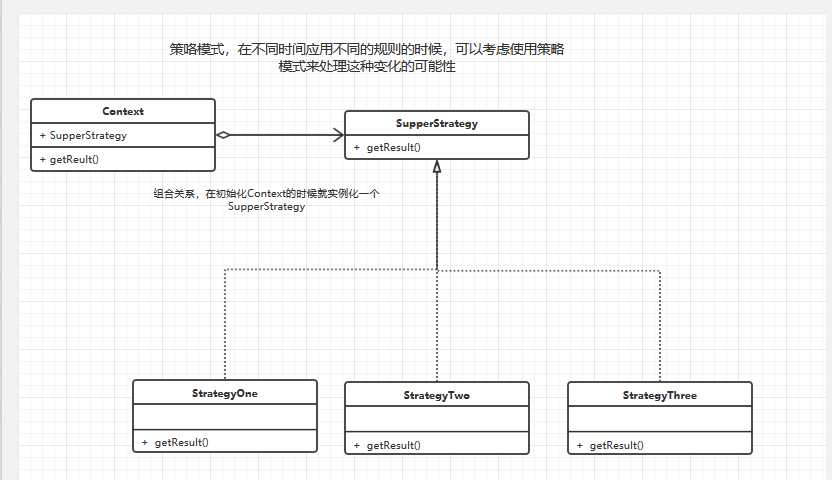策略模式:定义了算法家族,分别封装起来,让他们呢之间可以互相的替换,此模式让算法的变化不会影响到使用算法的客户。
UML类图:

解读:策略模式是定义一系列的算法,从概念上来讲,这些算法完成的工作都是一样的,只是他们的实现的不同,可以以相同的方式调用所有的算法,减少了各种算法类和算法调用类之间的耦合。
策略模式中的supperStrategy为context类提供了一系列的可供重用的算法或者行为。继承有助于提取出这些算法的公共功能。
在基本的策略模式中,选择所用具体实现的职责由客户端对象承担,并转给了策略模式中的对象context对象。
代码示例:
1 package com.dzf.designtest; 2 3 /** 4 * <desc> 5 * 策略模式:定义了一系列的算法,让这些算法之间可以互相的替换 6 * <p> 7 * </desc> 8 * 9 * @author dingzf 10 * @date 2018/4/1 11 * @time 11:23 12 */ 13 public class StrategyDemo { 14 //客户端 15 public static void main(String[] args) { 16 Context context1 = new Context(new StrategyOne()); 17 context1.operate();
//当我们需要使用哪种实现的时候,就选择哪种 18 Context context2 = new Context(new StrategyTwo()); 19 context2.operate(); 20 Context context3 = new Context(new StrategyThree()); 21 context3.operate(); 22 } 23 } 24 25 26 /** 27 * 策略模式中的上下文对象,引用策略模式中的策略类 28 */ 29 class Context{ 30 private SupperStrategy supperStrategy; 31 public Context(SupperStrategy supperStrategy) { 32 this.supperStrategy = supperStrategy; 33 } 34 public void operate(){ 35 if(supperStrategy!=null){ 36 supperStrategy.getResult(); 37 } 38 } 39 } 40 41 /** 42 * 策略类 43 */ 44 abstract class SupperStrategy { 45 public abstract void getResult(); 46 } 47 48 /** 49 * 策略子类1 50 */ 51 class StrategyOne extends SupperStrategy { 52 @Override 53 public void getResult() { 54 System.out.println("我会策略1号"); 55 } 56 } 57 /** 58 * 策略子类2 59 */ 60 class StrategyTwo extends SupperStrategy { 61 @Override 62 public void getResult() { 63 System.out.println("我会策略2号"); 64 } 65 } 66 /** 67 * 策略子类3 68 */ 69 class StrategyThree extends SupperStrategy { 70 @Override 71 public void getResult() { 72 System.out.println("我会策略3号"); 73 } 74 }
上面这种写法还是不太好,这样我们调用端需要知道两个类,我们可以改造下:
1 public class StrategyDemo { 2 //客户端 3 public static void main(String[] args) { 4 Context context1 = new Context("strategyOne"); 5 context1.operate(); 6 Context context2 = new Context("strategyTwo"); 7 context2.operate(); 8 Context context3 = new Context("strategyThree"); 9 context3.operate(); 10 } 11 } 12 13 14 /** 15 * 策略模式中的上下文对象,引用策略模式中的策略类 16 */ 17 class Context{ 18 private SupperStrategy supperStrategy; 19 public Context(String supperStrategy) { 20 switch (supperStrategy){ 21 case "strategyOne" : 22 this.supperStrategy = new StrategyOne(); 23 break; 24 case "strategyTwo" : 25 this.supperStrategy = new StrategyTwo(); 26 break; 27 case "strategyThree" : 28 this.supperStrategy = new StrategyThree(); 29 break; 30 } 31 } 32 public void operate(){ 33 if(supperStrategy!=null){ 34 supperStrategy.getResult(); 35 } 36 } 37 }
我们来使用简单工厂的方式来判断需要生成的对象,这样调用端只需要知道一个context类就可以啦。
选择所用具体实现的职责由客户端对象承担,并转给了策略模式中的对象context对象。
大家有没有发现代码上和简单工厂很类似,要说和简单工厂的区别,在代码上的体现就是调用端只需要知道context这个类,而使用简单工厂的时候,至少得知道两个类。进一步解耦和了吧,个人感觉策略模式是简单工厂的升级版,把策略模式和简单工厂合在一起使用更佳,当然大话设计模式里面也是推荐这样使用的。
最后:以上可以说是自己读大话涉及模式的一些读后感,如果有不对的地方,希望能够指正出来。
